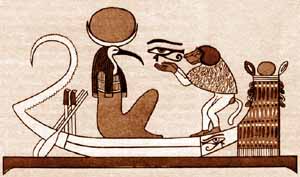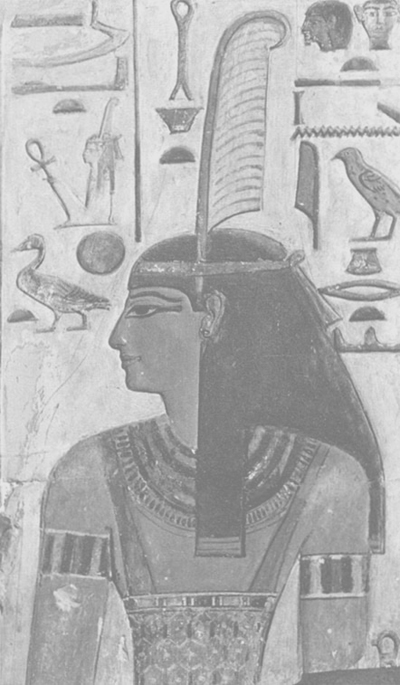First, Do Ma'at
It's tough to sum up 3,000 years of religious tradition in a short essay, and I've no intention of doing that. Instead, I'm going to touch on a quick history, a few theological high points, a smattering of practice, and some of what it all means to me.
History and Background
First and foremost, Kemetism is an African Traditional Religion. This means that it is related to other African religions, both of antiquity and of the present. It seems incredible to me that some people would deny this, but there's no accounting for taste. Ancient Kemetism was the faith and religion and way of life for the peoples of the Nile Valley during Pharonic and Classical times.
Modern Kemetism is, as far as can be accomplished, a reconstruction and continuation of that tradition and world view.
Over the centuries of Ancient Egypt's rise and fall (and rise and fall and rise and fall), the ancient religion influenced many of its neighbours, most notably the Nubians to the south, the Greeks to the north, and the Hebrews to the northeast. One can even detect the borrowings in the Book of Psalms from the Great Hymn to the Aten, written by King Amenhotep IV (Akhenaten).
Having its roots in the dimmest reaches of pre-literate antiquity, the ancient religion was only forcibly repressed in the sixth century CE by the Christian Roman Emperors, who decided that the One State Religion could brook no rivals. The last operating temple, that of Aset (Isis) at Pilak (Philae) was sacked by Roman Legionannaires in 550.
Theology? Sort of...
The ancient
religion was diverse, and it easily adopted new "Gods" and
practices into itself, because there was no such thing as an
inforced orthodoxy: every temple had its own practices and
traditions.
Having said
that, there were certain commonalities as a result of a common
language and world view. Other than the world view that held
the Community to be just as important as the individual,
probably the three most important concepts are pluriform
monotheism, Sep Tepi, and Ma'at.
Pluriform
Monotheism is a deep and complicated subject, and I won't
be able to do it justice. Basically, there is one divine
energy, force, God, or whatever, called "Netjer".
Netjer
manifests itself in a multitude of forms and personalities,
some of which actually overlap slightly, these "Netjeru", or
Gods, or Names are what we usually think of when we think of
the "Egyptian Pantheon": Ra, Amen, Aset (Isis), Heru (Horus),
Djehuty (Thoth), etc.
So, is
Kemetism monotheistic, pantheistic, or polytheistic? The
answer must be ... yes.
Sep
Tepi is literally the moment of Creation or Genesis. The
Ancients had four (or more) versions of the Creation myth.
They were to a large extent mutually exclusive, but all were
held to be true. How can this be? The Universe is infinite and
the Human brain is what? Two pounds? There's no way that
you're going to be able to wrap your brain around the
Universe.
Each myth
looks at Creation from a slightly different point of view,
using different metaphors. They are different, but they are
all True. What they have in common is this: that before there
was anything, there was nothing (the Nun, or watery abyss).
And then, some part of the Nun became self-aware (Atum), and
it was all downhill from there. (Literally - in some myths,
the moment of creation is depicted as the First Hill (Ben-Ben)
rising from the Deep.)
That moment
of Creation, the "Sep Tepi" or First Time, since it occurs
before Time, happens continuously forever.
 Djehuti presents the Eye of Heru to Himself
Each day at
our Daily Rite, we participate in Sep Tepi. Each moment of
every day that we live our lives is as fresh and new as
Creation because it is Creation. It's an amazing way
to live.

Ma'at is the trickiest of all. Usually translated
as "justice", Ma'at is:
- a female Netjer depicted with an ostrich
feather,
- the harmony, order, and proper unfolding of
the Unverise (like the Tao),
- your correct participation in the proper
unfolding of the universe (including proper rites, very much
like Confucianism), and
- a system of ethics.
At the judgement of the dead, the deceased heart
is weighed against the ostrich feather of Ma'at. Those who are
in balance pass on, those who are not are devoured and their
spirit perishes. Ma'at has no comprehensive written rules,
although the Ancients wrote exhaustively on the subject in a
genre now called "Wisdom Texts". My favourite is The
Instruction of Amenemope, which spends some time
contrasting the "silent" or serene man with the "hot-headed"
man. It includes this, one of my favourite phrases: "Fill
yourself with silence; you will find life and your body shall
flourish upon the earth". Ma'at is a difficult concept to get a handle on,
and more difficult to explain. The Ancients held that you
cannot teach it except by example; those who would teach
Ma'at, must breath Ma'at.
Practice
The most important, and most difficult part of my religious practice is to "Do Ma'at". I have a shrine in my apartment with images of Djehuty (Thoth), Bast, Anpu (Anubis - in LEGO no less), and Sekhmet.
Each day (mostly) I perform a Daily Rite to fulfill my ritual obligations under Ma'at, to be with Netjer for awhile, and to sacrifice. At the altar, one wears no black (preferably only white), no leather, and no wool. The images of the Netjeru are contained within a Naos box, which is ritually opened. There are candles and incense and prayer. At the conclusion, the Naos is closed.
The year is filled with numerous holidays and festivals, where we try to gather fellow Kemetics together for ritual, feasting, and fun.
What Does it all Mean?
There is a magic in my faith that I can't quite explain. When I'm in the intimate presence of my patron Djehuty, all is right with the world. I am protected, loved, challenged, and occasionally berated.
The admonition to "Do Ma'at" informs every decision I make every day. It's difficult, but I believe that my community and my friends benefit as much or more than I do.
I don't always live up to my ideals, but they're always there, pushing me, chiding me, reminding me to live a life that will benefit both myself and those around me. As part of this, I accept responsibililty for all of my decisions, and expect the same level of responsibility in others, particularly those selected for high office.
I try to live every moment as Sep Tepi, seeing the wonder of Creation. I try to be the Silent Man, remembering always this: I have the responsibility for my fellow Humans, just as much as for me. To see something that must be done and to not do it is an act of moral cowardice.
|
